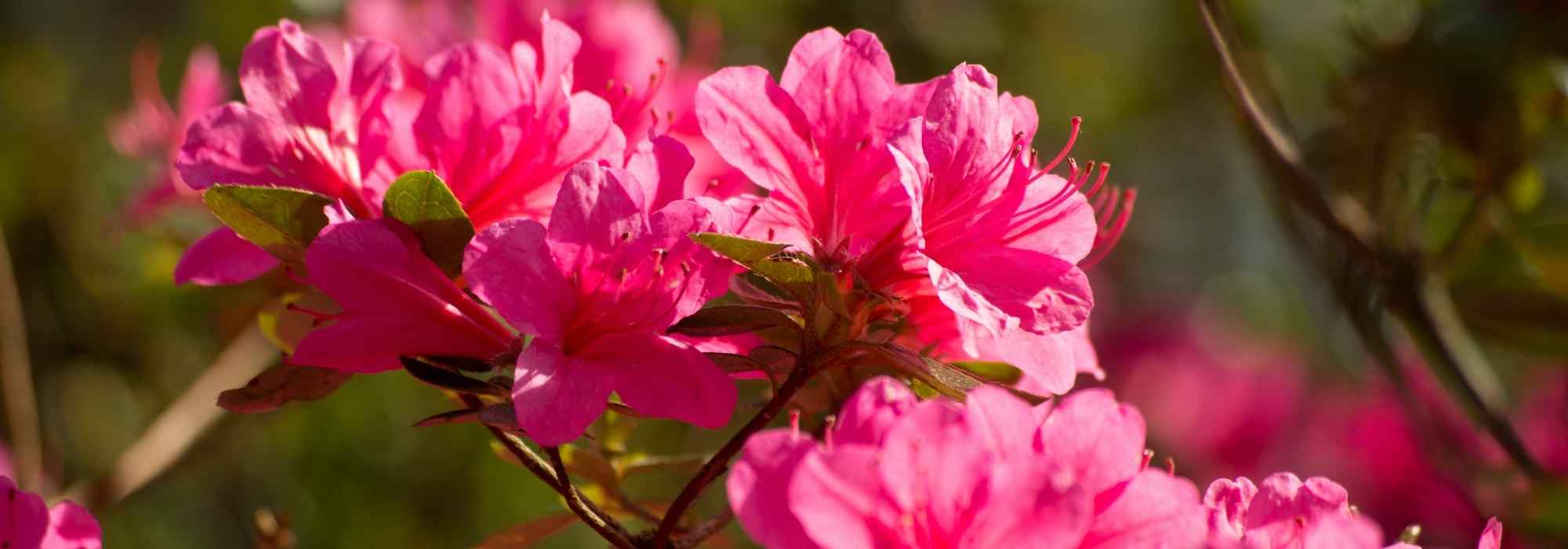
How to choose an azalea?
Buyer's guide
Contents
Buying an Azalea is not necessarily simple because of the diversity of varieties and colours within the genus. Although often placed in genus Rhododendron, with which they share a resemblance in terms of flowers, they are clearly distinguished by smaller dimensions and foliage that is not always evergreen, depending on whether one is referring to the Chinese azalea or the Japanese azalea. Iconic spring plants, extremely popular, these acid-soil bushes grow in shady positions, are very hardy and easy to maintain. Azaleas are highly ornamental in Japanese-style settings, in shady rock gardens and in any garden bed where they bring much refinement.
Spectacular flowering displays, freshness of colours, varied silhouettes, leaf colour, flower shapes, sizes… there is so much to say about these Asian bushes… You may hesitate when choosing from the hundred or so varieties available. Discover our advice to help you see more clearly and choose the ideal Azalea for your garden!
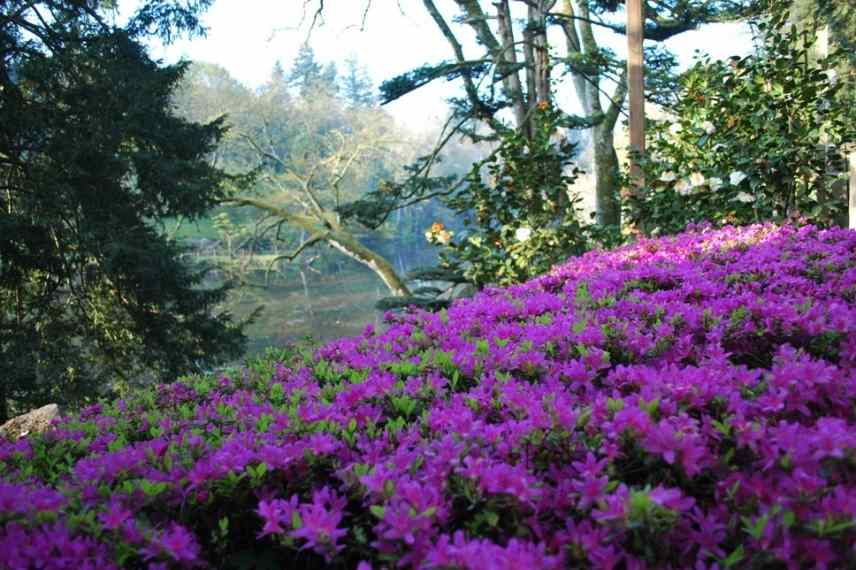
Azaleas © Parc oriental de Maulévrier
Depending on foliage persistence
This is certainly the main criterion that will make you choose one azalea over another: Chinese Azaleas (also called Azalea mollis or hybrid azaleas) are plants with deciduous foliage, whereas Japanese Azaleas retain their foliage all year round. An important criterion, therefore, depending on where in the garden you want to plant it, so that with Japanese azaleas you can enjoy year-round foliage. Deciduous azaleas will offer a more striking display in autumn, with colour variations in the foliage for some varieties.
Discover our range of Japanese Azaleas and our range of Chinese Azaleas
Depending on its dimensions
Azaleas are all slow-growth plants, their vegetation not exceeding 2 m, unlike Rhododendrons which can readily reach 4 m or more. Overall, azalea mollis (deciduous) are taller than Japanese azaleas, with a size reaching up to 2 m, while Japanese azaleas remain below 1.50 m with a spread of 80 cm at most.
In small gardens, rockeries or patios, opt for smaller varieties, Chinese azaleas 1.20 m high at ripeness with about 1 m of spreading, and above all Japanese azaleas: the Japanese ‘Nakaharai Orange’ (0.50 m) suitable for growing in a pot, the carmine red ‘Johanna’ (0.60 m high by 0.50 m wide), the sublime mauve ‘Koromo Shikibu’ or the white ‘Adonis’ with compact habits (60 cm x 80 cm).
Among the tallest azaleas to plant in large borders or as specimens are some superb Chinese azaleas: Azalea Rhododendron luteum—this one is actually European—(2.50 m), ‘Koster’s Brillant Red’ (1.60 m), ‘Fire Ball’ and ‘Homebush’ (1.50 m), and the azalea mollis ‘Viscosa’ (1.75 m). These dimensions are reached at 10 years.
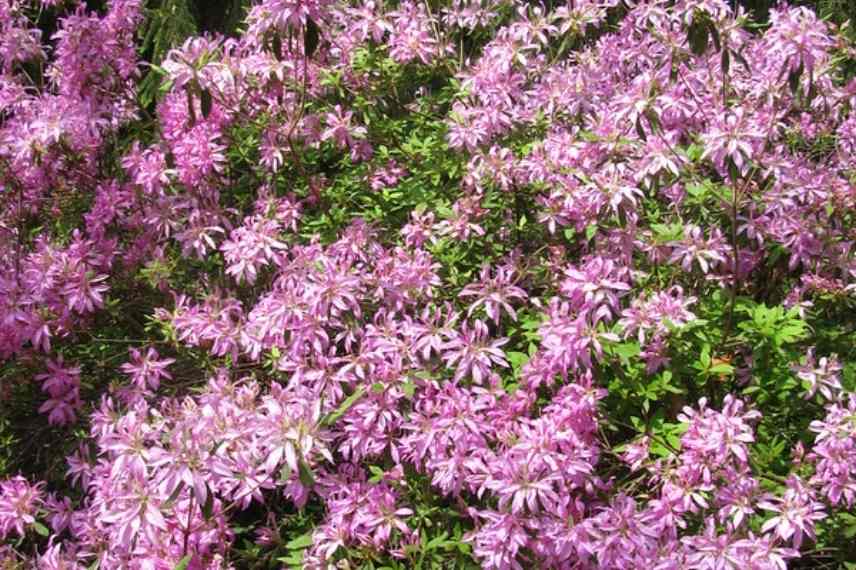
Compact and charming ‘Koromo Shikibu’ (Photo : Pohick2)
Discover other Rhododendron and Azalea
View all →Available in 1 sizes
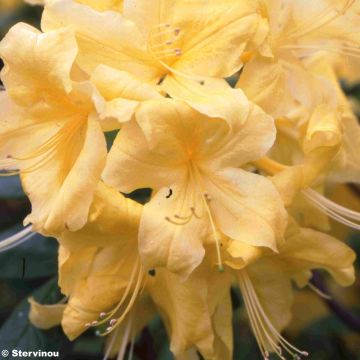
Available in 1 sizes
Available in 1 sizes
Available in 3 sizes
Available in 1 sizes
Available in 1 sizes
Available in 1 sizes
Available in 1 sizes
Available in 1 sizes
Available in 1 sizes
Depending on flower colour
Colour of inflorescences will certainly play a major role in your choice, so true that the azalea palette is sumptuous, ranging from pure white, to cream maculate with yellow, to bright yellow, to orange, to pink, to mauve and violet. The range of pinks is particularly extensive: tender pink, salmon pink, bright pink, fuchsia pink, orange-red, bright red. Yellow is found more often in Chinese azaleas; white azaleas bring real light to the darkest spots and often serve as a link between different colours. Some are slightly speckled or striate, others have very contrasting stamens. Among the some 500 known varieties, here are a few azaleas with the softest or most brilliant tones (Chinese azaleas display a larger range of warm tones, while Japanese ones are particularly well represented in pink to violet tones)
- Ultra-elegant whites: ‘Schneewittchen’, ‘Daviesii’ and ‘Persil’, and from the Encore® series ‘Ivory’
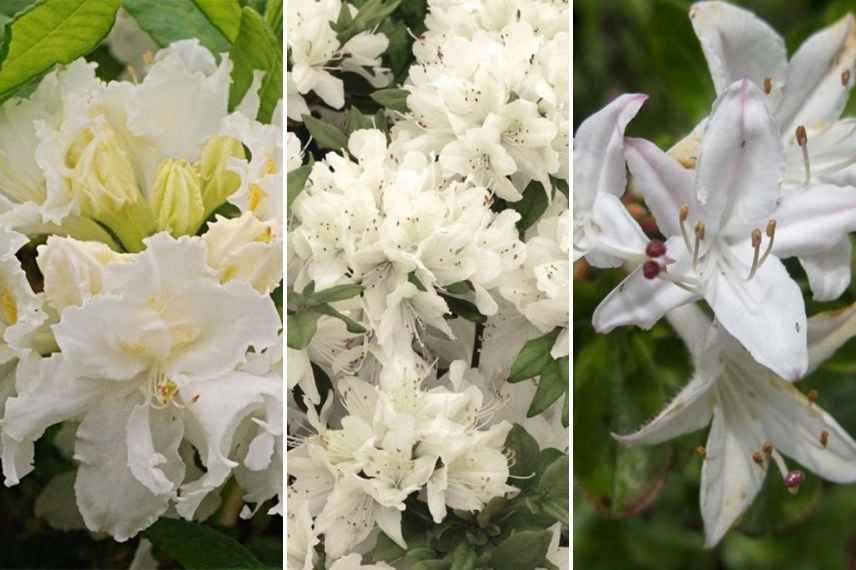
Chinese azalea ‘White Frills’, Japanese azalea ‘Schneewittchen’, and mollis azalea ‘Viscosa’
- Yellows: azalea mollis luteum (also called Rhododendron flavum or pontic azalea), deciduous, with large tubular golden-yellow scented flowers. It grows up to 3 m tall, or ‘Harvest Moon’ of a pale yellow washed with coral at its centre
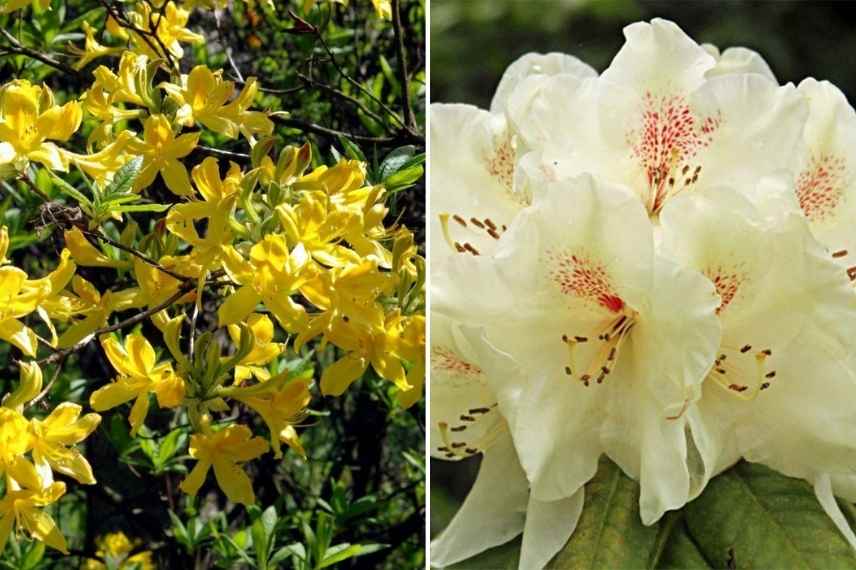
Pontic azalea and Chinese azalea ‘Harvest Moon’
→ Also read: 5 Chinese azaleas with yellow flowers
- Pinks: ‘Blaauw’s Pink’ salmon-pink, ‘Mme Van Hecke’ soft pink, Chinese azalea ‘Kilian’ bright pink and Chinese azalea ‘Irene Koster’ very pale pink
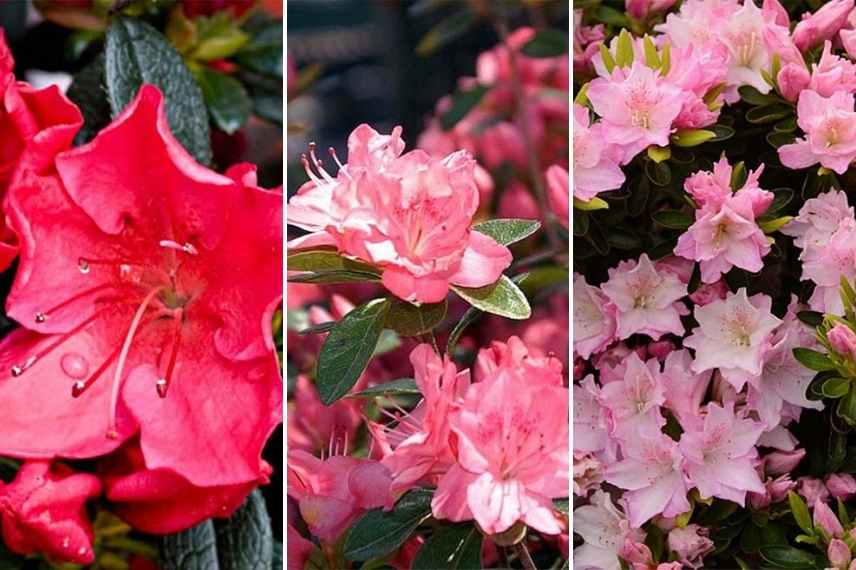
Japanese azaleas: ‘Vuyk’s Rosyred’, ‘Blaaw’s Pink’, and ‘Al’s Picotee’
Discover our selection of most beautiful Japanese azaleas with pink flowers!
- Orange-reds: ‘Koster’s Brilliant Red’, and Chinese ‘Glowing Embers’, ‘Brazil’ mandarin-coloured, and ‘Fire Ball’ a very beautiful bright orange-red
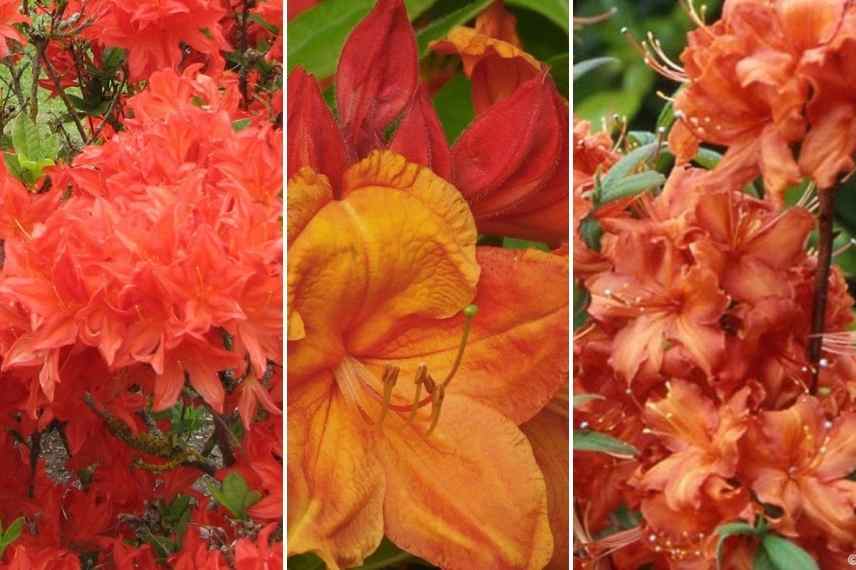
Chinese orange azaleas: ‘Brilliant Red’, ‘Glowing Embers’ and ‘Fireball’
- Mauves: the superb Japanese azalea ‘Koromo Shibuku’, ‘Amoena’ and ‘Sylvester’, the violet-tinged ‘Blue Danube’
- Variegated: often the throat of the flower is maculate with a darker colour: the Japanese ‘White Prince’, ‘Berry Rose’ a magnificent pale pink with an orange macule, ’Persil’ and ‘Mount Rainier’ white with a yellow macule, ‘Jolie Madame’…
By flower shape
Most azaleas bear tubular flowers, that is, trumpet-shaped. They are arranged in corymbs (clusters) of around ten flowers on some azaleas.
Single flowers (‘Daviesii’), semi-double (such as ‘Rosa King’ or ‘Cannon’s Double’), or double (‘Rex’), large pompon-like flowers like the Chinese azalea ‘Homebush’, with narrow corolla like ‘Fragrant Star’, surprisingly resembling lilies (‘Daviesii’), or slender and finely cut like the striking spider azalea (‘Koromo Shikibu’), undulated or frilled on their edges (‘Harvest Moon’, ‘White Frills’)… azaleas never cease to surprise us!
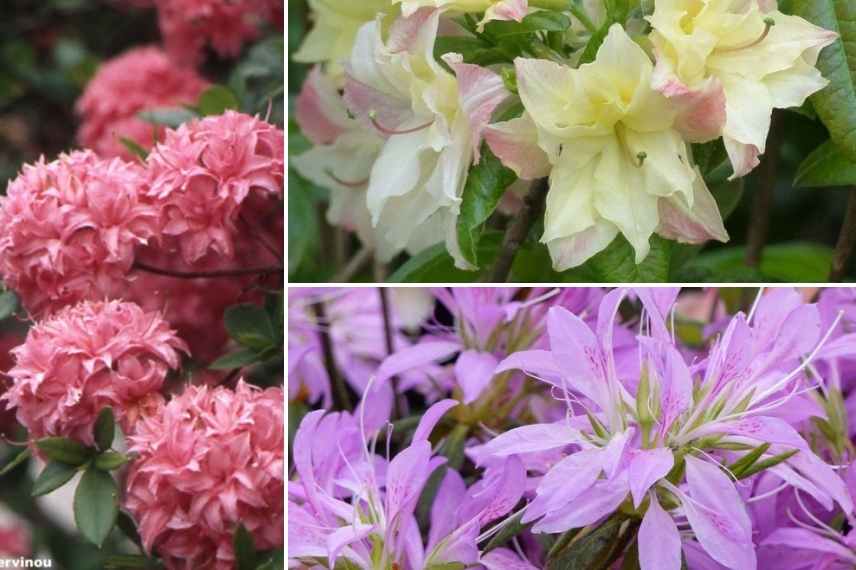
Chinese azaleas ‘Homebush’ and ‘Cannon’s Double’. Bottom right: Japanese azalea ‘Koromo Shikibu’
Depending on flower size
Azaleas have medium-sized flowers (between 2 cm and 5 cm), but in such quantities at peak flowering that they literally make foliage disappear. Azalea ‘Hino Crimson’ is the perfect example: it is covered in very small flowers (about 1 cm in diameter), its floribundity is truly remarkable. That is also the case for ‘Amoena’, whose pink completely covers the plant.
Some azaleas, by contrast, produce large inflorescences worthy of the finest rhododendrons, with flowers around 10 cm in diameter, such as the Pontic azalea. The gentle ‘Harvest Moon’ and the flamboyant ‘Wallowa Red’ are two other Chinese azaleas with very large inflorescences. With their flowers measuring between 6 and 8 cm, these Japanese azaleas are also splendid: ‘Arabesk’, Beethoven, ‘Palestrina’, Red Wing, ‘Rosa King’, ‘Vuyk’s Scarlet’ and ‘Vuyk’s Rosy Red’
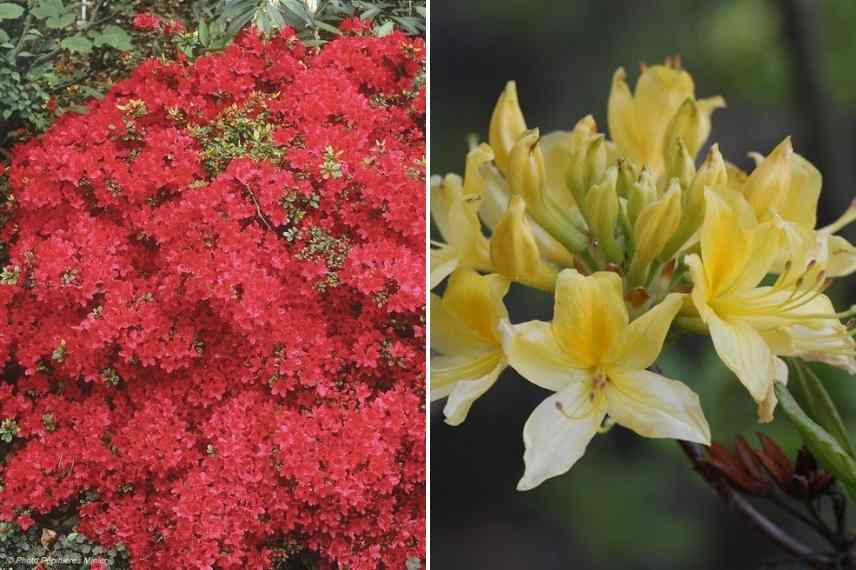
Japanese azalea ‘Hino Crimson’ on left, and azalea luteum on right (Photo: Miltos Gikas)
Depending on foliage colour
Azalea foliage, whether deciduous or evergreen, is also interesting, as although often quite dark, it sometimes emerges coppery or light green, and is especially changeable in autumn for many deciduous cultivars, allowing multiple combinations within beds to create contrast.
- Spring foliage : Few varieties have light-coloured leaves: Japanese azalea ‘Eucharis’ with apple-green leaves in spring and ‘Palestrina’ offer a lovely brightness through their foliage. Both produce magnificent white flowers. Japanese varieties ‘Berry Rose’, ‘Fire Ball’ and ‘Saturnus’ have coppery young shoots.
- Marginate : Japanese azalea ‘Silver Queen’ is atypical with its foliage marginate with white, elegantly highlighting its leaves.
- Autumn colours : Japanese “Maruschka” turns bronze from autumn, the Chinese ‘Daviesii’ and ‘Lingot d’Or’ and ‘Hot Shot’ display purple shades, as does Japanese ‘Johanna’.
‘Mme Van Hecke’, Chinese azalea ‘Anneke’, ‘Glowing Embers’, are also varieties to choose for their striking autumn foliage. ‘Jolie Madame’ proudly sports stunning red-to-orange foliage!
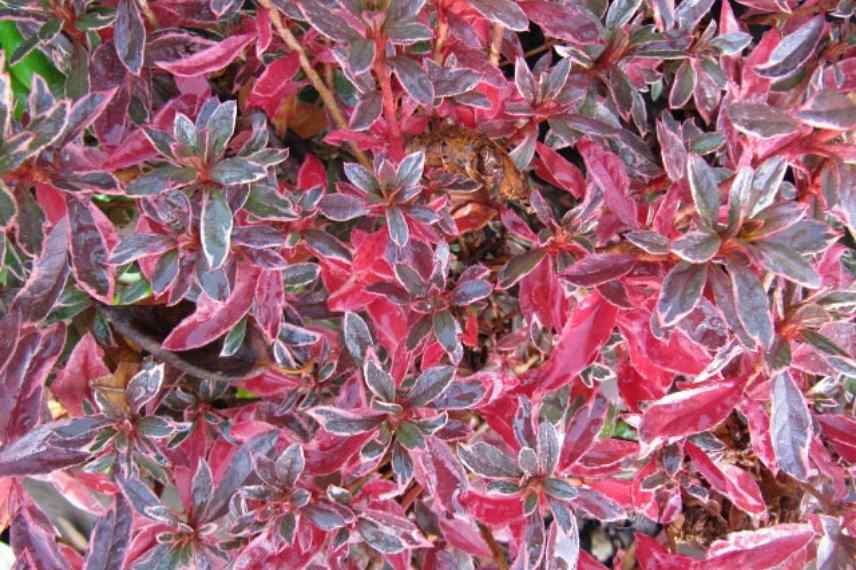
Foliage of Japanese azalea ‘Hot Shots’ in autumn (Photo: Leonora Enking)
Depending on the flowering period
Bushes known as ericaceous, azaleas flower like most of these plants in spring, between April and May. Some are slightly earlier and begin to be covered with flowers as early as March, while others will only flower late in June. Flowering lasts several weeks, which makes azaleas very interesting ornamental shrubs. By combining several varieties, you get an explosion of flowers for several months! Beware of forced azaleas sold in garden centres that you find in flower in winter: they are intended as indoor plants and will struggle to perform in open ground where they prove to be not very hardy.
Among the early varieties flowering from March are the Japanese ‘Hino Mayo’ in pale pink, ‘Hino Crimson’ , ‘Kirin’ light pink, or ‘Coral Bell’ and ‘Sylvester’ deep pink.
Some varieties begin flowering at the end of May or the start of June: the Japanese ‘Addy Wery’, ‘Christina’, Vuyk’s Rosyred, and the Chinese ‘Arpège’, ‘Brazil’, the orange ‘Glowing Embers’, the white ‘Daviesii’, ‘Klondyke’ and ‘Saturnus’.
Finally, hybrid azaleas from the ‘Encore’® range are perpetual: they flower two to three times a year, from spring to autumn! Of horticultural origin, evergreen, they even tolerate sun. Discover our perpetual azaleas favourites in Alexandra’s article.
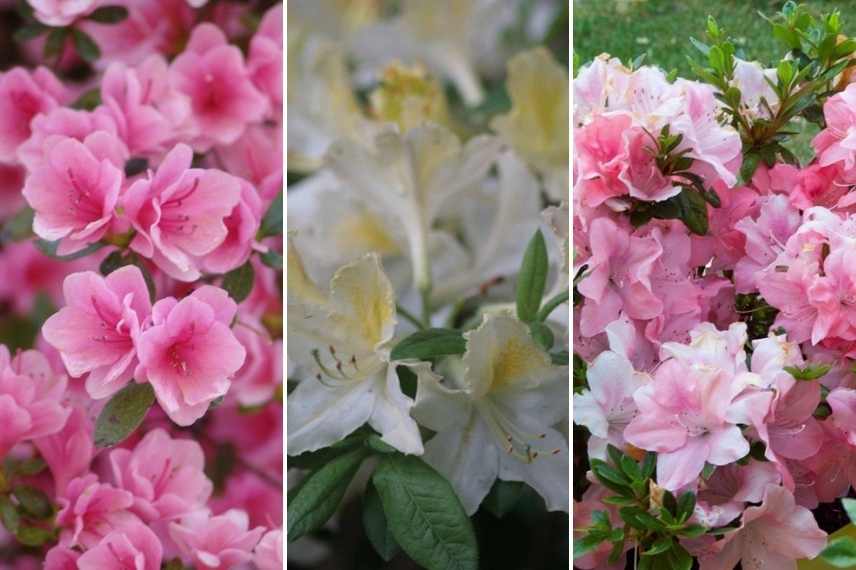
Azalea ‘Kirin’, Azalea ‘Daviesii’, and Encore® Azalea ‘Débutante’
Depending on its habit
Azaleas generally have a spreading habit and, at maturity, are typically wider than they are tall. Japanese azaleas form a bushy silhouette. Some cultivars have a more upright habit, such as Japanese ‘Blaaw’s Pink’ or ‘Palestrina’, while others are naturally erect, like the Chinese azalea ‘Homebush’. Chinese azaleas are generally taller than their Japanese counterparts, and are therefore best positioned at the back of a border or used as specimens.
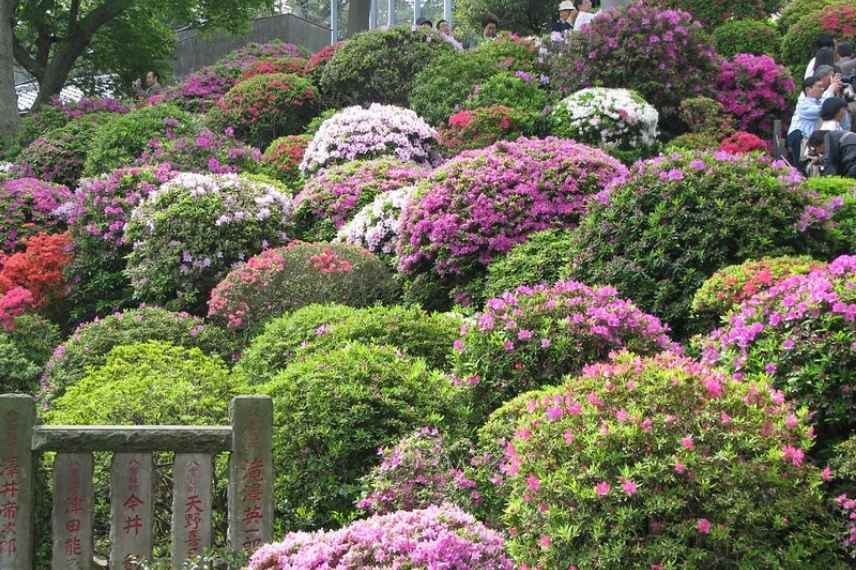
Azaleas in a garden in Tokyo (Photo: Charlotte Marillet)
Depending on its hardiness
Native to north‑east Asia, azaleas are very hardy in general, withstanding temperatures down to -26°C for deciduous varieties. You can therefore plant them anywhere in France. Japanese azaleas are somewhat less hardy, generally between -10°C and -15°C.
All azaleas, whether Chinese or Japanese, have a superficial root system that spreads horizontally. You should simply ensure it is protected in regions with harsher winters during the first years, by applying mulch around their base.
Finally note that early‑flowering azaleas in March, even if hardy, require a particularly sheltered position, protected from wind.
According to its fragrance
If scent particularly appeals to you, opt for Chinese azaleas, which are more fragrant, bearing in mind that azalea fragrance remains subtle. Scent is more noticeable where the plant receives a little more sun, as is the case with Chinese azaleas.
The Chinese azalea luteum, or Pontic azalea, is undoubtedly the most fragrant, with honeyed notes and is very nectariferous. You can also plant the white azaleas ‘Persil’ and ‘Daviesii’ and the charming rose‑orange ‘Jolie Madame’ for their very pleasant scent. ‘Harvest Moon’, with a honeysuckle‑like fragrance, ‘Irene Koster’, ‘Narcissiflora’, ‘Arpège’, ‘Balzac’ and ‘Corneille’, with a rose‑like scent, are other delicately scented cultivars.

Chinese azalea ‘Persil’, ‘Jolie Madame’ and ‘Narcissiflora’
Varieties suitable for pots
You will have no shortage of choice if you wish to plant an azalea in a pot, due to their often compact size. We suggest, for example, the lovely Japanese azalea ‘Blaauw’s Pink’ (salmon-pink), the Japanese azalea ‘White Prince’ (almost bicoloured white and pink), the azalea ‘Johanna’ in a vivid carmine red, or the perpetual Encore azalea ‘Bonfire’. All these cultivars measure between 50 cm and 70 cm in height at ripeness (after 10 years).
- Subscribe!
- Contents
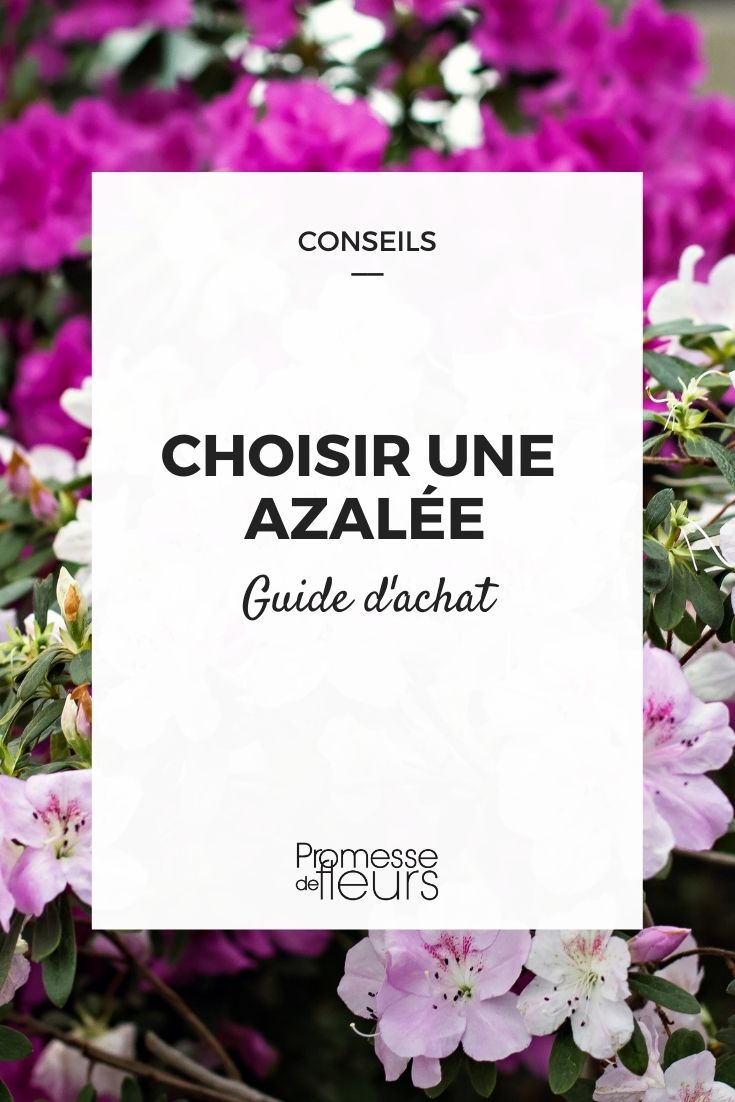































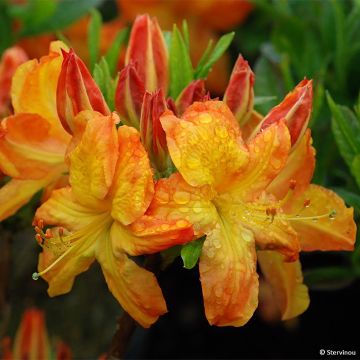
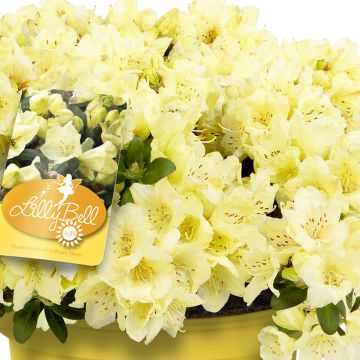
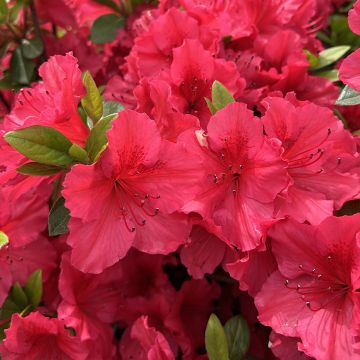
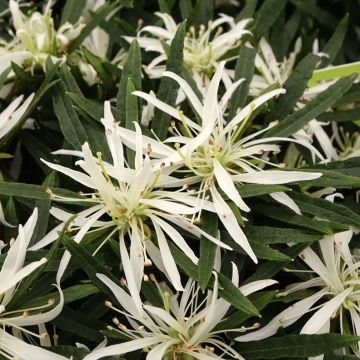
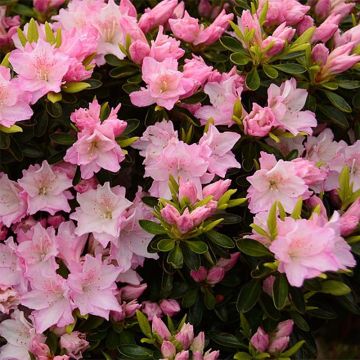
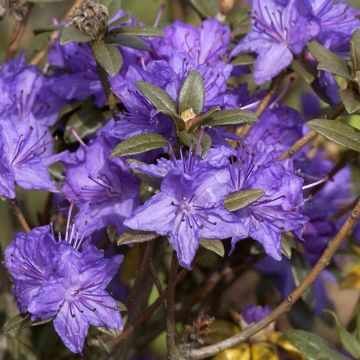
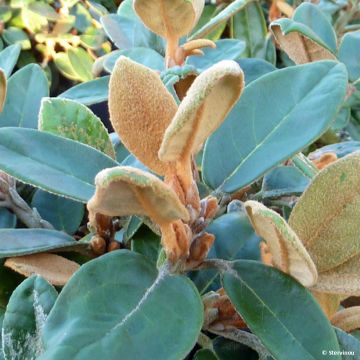
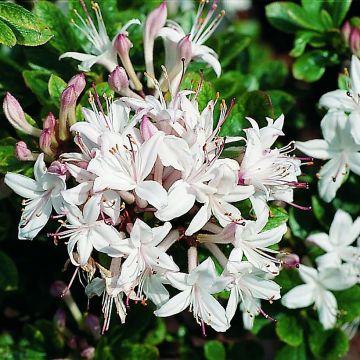
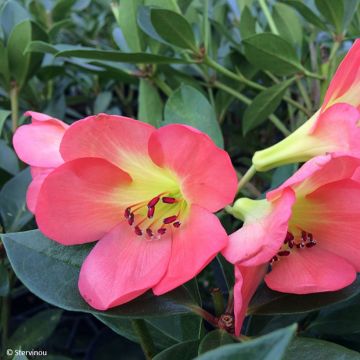
Comments